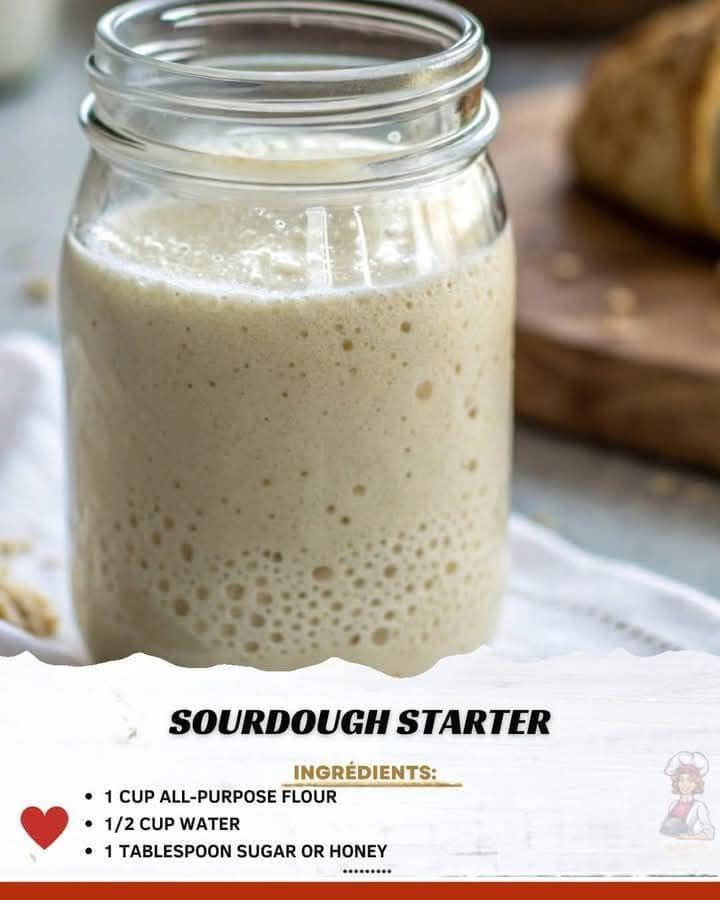Introduction:
Sourdough starter is the foundation of traditional sourdough bread, a naturally leavened bread that has been cherished for centuries. Unlike commercial yeast, a sourdough starter is a living culture of wild yeast and lactic acid bacteria that ferments flour and water, creating a distinctive tangy flavor and a beautifully airy texture. Making a sourdough starter from scratch requires patience, but the reward is a reliable, long-lasting leavening agent that enhances the flavor and nutrition of homemade bread.
Origin and Cultural Significance:
Sourdough has been a staple in human diets for thousands of years, dating back to ancient Egypt around 1500 BC. Before commercial yeast was available, bakers relied on naturally occurring wild yeast to ferment their dough. Sourdough techniques have been passed down through generations, with unique variations developing in different regions. San Francisco-style sourdough is one of the most famous examples, known for its tangy taste due to specific strains of lactic acid bacteria. Sourdough remains significant in traditional baking cultures worldwide and is valued for its depth of flavor and digestibility.
Ingredients Quantity:
- 1/2 cup (60g) whole wheat or unbleached all-purpose flour
- 1/4 cup (60ml) filtered or dechlorinated water
Optional Additions:
- A small amount of unsweetened pineapple juice (to encourage yeast growth in the early stages)
- A pinch of honey or sugar (to boost fermentation)
- A bit of rye flour (to enhance microbial activity and flavor)
Tips for Success:
- Use filtered water – Chlorine in tap water can inhibit yeast growth.
- Maintain a consistent feeding schedule – Feed your starter daily at the same time for the first week.
- Store in a warm environment – Ideal fermentation temperature is between 70-75°F (21-24°C).
- Use a breathable cover – A loose lid or cheesecloth allows airflow while preventing contamination.
- Be patient – A starter can take 5-7 days to become fully active. Discarding half and feeding regularly helps strengthen it.
- Look for signs of activity – Bubbles, a tangy aroma, and a slight rise indicate a healthy starter.
Instructions:
- Day 1: In a clean glass jar, mix flour and water until well combined. Cover loosely and let it sit at room temperature.
- Day 2: Check for bubbles. If none appear, stir and let it sit another 24 hours.
- Day 3-7: Discard half of the starter and feed with equal parts flour and water daily. By day 5-7, the starter should be bubbly and have a tangy smell.
- Testing Readiness: Drop a spoonful of the starter into water. If it floats, it’s ready for baking. If not, continue feeding until it gains strength.
- Storage: Once mature, store in the refrigerator and feed weekly to maintain activity.
Description:
A well-maintained sourdough starter is thick, bubbly, and aromatic, with a slight tangy scent. Its flavor varies based on fermentation time and ingredients used. The starter serves as the natural leavening agent for sourdough bread, yielding a complex taste and chewy texture that set it apart from commercially yeasted bread.
Nutritional Information (Per 1 Tbsp of Starter):
- Calories: 15
- Carbohydrates: 3g
- Protein: 0.5g
- Fiber: 0.2g
- Naturally occurring probiotics and beneficial enzymes
Conclusion:
A sourdough starter is a rewarding and sustainable way to bake naturally leavened bread. With minimal ingredients and a little patience, you can cultivate a starter that will last for years and yield delicious homemade bread with superior texture and flavor.
Recommendation:
Once your starter is active, experiment with different flours, hydration levels, and fermentation times to develop a unique flavor profile. Try incorporating it into recipes beyond bread, such as pancakes, waffles, and crackers.
Embracing Healthful Indulgence:
Sourdough is not just a bread-making tradition but a testament to slow, natural fermentation that enhances both flavor and nutrition. The presence of probiotics and reduced gluten content makes sourdough easier to digest. Baking with a homemade starter allows for a deep connection to the food you create, making each loaf a wholesome and nourishing indulgence.
